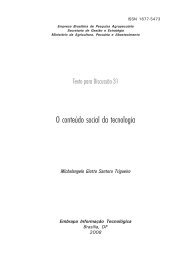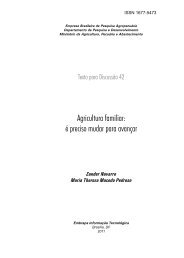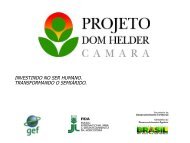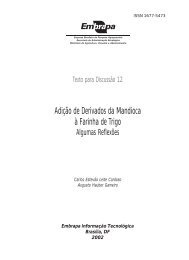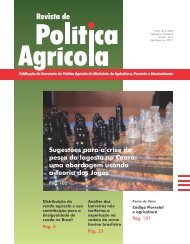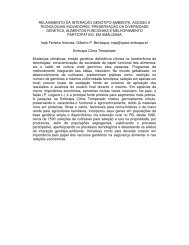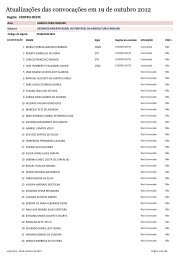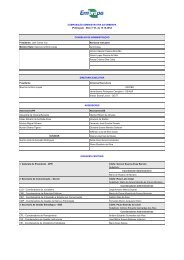Ministry of Agriculture, Livestock and Food Supply - Embrapa
Ministry of Agriculture, Livestock and Food Supply - Embrapa
Ministry of Agriculture, Livestock and Food Supply - Embrapa
You also want an ePaper? Increase the reach of your titles
YUMPU automatically turns print PDFs into web optimized ePapers that Google loves.
in Brazil's share <strong>of</strong> the international sugar market, while the world moves towards<br />
using ethanol as fuel oxygenant, as we do.<br />
It is estimated that a sugarcane supply <strong>of</strong> 220-million tons would require<br />
increasing the sugarcane-farmed area by almost 3-million hectares in the next 6<br />
to 8 years.<br />
The goal <strong>of</strong> planting three million hectares could be substantially reduced<br />
by means <strong>of</strong> continuous, substantial productivity gains <strong>and</strong> by increasing sucrose<br />
contents. Either way sugarcane plantations occupy only 10% <strong>of</strong> the total planted<br />
area <strong>and</strong> much farmable l<strong>and</strong> is still available in the country, particularly in the<br />
Cerrado22 .<br />
Brazil faces other more worrisome internal <strong>and</strong> external challenges that<br />
involve government policies <strong>and</strong> the large public <strong>and</strong> private investments required<br />
to meet the growing domestic <strong>and</strong> foreign dem<strong>and</strong>s. Despite the pioneering spirit<br />
<strong>and</strong> technical qualifications <strong>of</strong> our industry, as well as the lower costs <strong>and</strong><br />
considerable potential to increase production, such challenges require concerted<br />
planning <strong>and</strong> action by both government <strong>and</strong> private sector.<br />
The first <strong>and</strong> perhaps greatest challenge relates to the size <strong>of</strong> the world<br />
fuel-alcohol market. Half <strong>of</strong> Brazil's sugarcane production suffices to replace 40%<br />
<strong>of</strong> the gasoline consumed in the country, while world ethanol production <strong>and</strong><br />
dem<strong>and</strong> are still insignificant, although quickly growing.<br />
It is absolutely essential to seek partnerships, particularly with other<br />
sugarcane producer countries. They could follow in the steps <strong>of</strong> the Brazilian<br />
agro-industry, invest in improving the use <strong>of</strong> their raw material by diversifying<br />
production <strong>and</strong> improving sugarcane quality, which would give them access to<br />
two different markets: the food market <strong>and</strong> the energy market. Alcohol production<br />
can be an alternative for countries benefiting from special USA <strong>and</strong> EU quota<br />
regimes, such as the Caribbean <strong>and</strong> Pacific countries (ACP). In turn, this would<br />
bring Brazil closer to them <strong>and</strong> dispel any dissatisfaction caused by the WTO<br />
panel brought by Brazil, Australia <strong>and</strong> Thail<strong>and</strong> against the European sugar regime<br />
from which they benefit.<br />
In addition, alcohol production in the ACP countries would mean more<br />
dem<strong>and</strong> for Brazilian services <strong>and</strong> industrial equipment, as well as new<br />
investment opportunities abroad focusing on new markets.<br />
Contacts with countries that have a large dem<strong>and</strong>, particularly the United<br />
States, for the purpose <strong>of</strong> working together to define international technical<br />
22 The pasture area with some degree <strong>of</strong> degradation is estimated at 50-million hectares, most <strong>of</strong> it in the<br />
Cerrado.<br />
78



